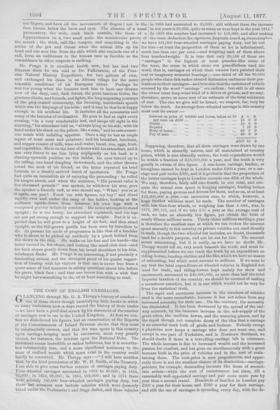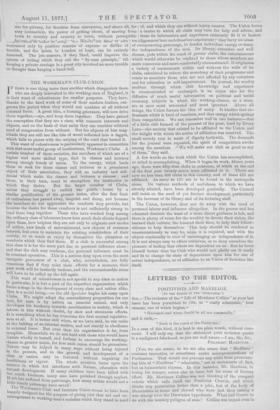THE COST OF ENGLISH CARRIA.GES.
GLANCING through Mr. G. A. Thrupp's history of coaches— one of those clever though unsatisfying little books in which so many tradesmen now-a-days record the history of their trades —we have been a good deal struck by his statement of the number of carriages now in use in the United Kingdom. At first we con- fess we disbelieved his figures, but an examination of the Reports of the Commissioners of Inland Revenue shows that they must be substantially correct, and that the sum spent in this country upon carriage-keeping must be enormous, must very greatly exceed, for instance, the interest upon the National Debt. The statement seems incredible or rather ludicrous, but it is neverthe- less substantially true, and a more significant testimony to the mass of realised wealth which must exist in the country could hardly be conceived. Mr. Thrupp says :—" I will here mention that, by the kind permission of Mr. W. H. Smith, of the Treasury, I am able to give some further returns of carriages paying duty. Four-wheeled carriages amounted in 1834 to 49,000; in 1844, 62,000; in 1854, 68,000; in 1864, 102,000; and in 1874 there were actually 150,000 four-wheeled carriages paying duty, but these last numbers now include vehicles which were formerly taxed under the Postmaster's and Stage duties, and these vehicles
in 1864 had amounted to 25,000; still without them the increase in ten years is 23,000, quite as many as were kept in the year 1814."
In 1876 this number had increased to 156,000, and after making of_ the _same _define Wm...far _astri aizeislersn isised_ag eta aeseoneh e we have 131,000 four-wheeled carriages paying duty, not let out for hire—at least the proportion of them so lot is infinitesimal, much less than one per cent —and weighing each of them above four hundredweight. It is true that only 20,156 of these are " carriages " in the highest or most grandee-like sense of the term, the sense in which alone our grandfathers used the word, that is, carriages on which their owners have painted their real or imaginary armorial bearings ;—one-third of all the 60,000 people who claim this rather absurd distinction emblazon their pre- tensions on their carriages—and true also that the varieties of vehicle covered by the word " carriage " are endless ; but still in all cases the owner must keep some kind of a driver or groom, and we may, therefore, arrive at some sort of an estimate of the total minimum of cost. The one we give will be found, we suspect, far, very far below the truth, An average four-wheeled carriage in this country must cost its owner :— Interest on price of vehicle and horse, taken at 10 s. d.
per cent. on £150 ••• ••• .1• 150
0
Stable ... ••• •" •••
10 0 0 Repairs ... 710 0 Keep of horse... ... 85 0
Pay of man ... •••
40 0 0
£107 10 0
Supposing, therefore, that all these carriages were drawn by one horse, which is absurdly untrue, and all maintained at country prices, which is also absurdly untrue, the total expenditure would be within a fraction of £18,000,000 a year, and the truth is very greatly in excess of this figure. A one-horse carriage, landau, or brougham cannot be kept in London under £200 a year, or a car- riage and pair under 1300, and it is probable that the proportion of the better carriages kept in London exceeds one-fifth of the whole. We may, therefore, fairly add one-fourth to our total, and esti- mate the annual sum spent in keeping carriages, feeding horses for them, paying grooms and drivers for them, and so on, at at least 222,000,000 a year,—an enormous sum, to which, however, a huge further addition must be made. The number of carriages with less than four wheels, or weighing less than 4 cwt., was, in 1876, 298,163, and if we take £50 a year as the average cost of each, we take an absurdly low figure, yet obtain the total of nearly fifteen millions more. Thirty-three millions sterling a year is therefore the smallest sum at which we can reckon the amount spent annually in this country on private vehicles not used directly in trade, though the two-wheeled list includes, no doubt, thousands used for a double purpose, and not let out for hire. The amount seems astonishing, but it is really, as we have no doubt Mr. Thrupp would tell us, very much beneath the truth, and must be supplemented before we can reach the truth by an expenditure on riding-horses, hunting-stables, and the like,which we have no means of estimating, but which must amount to millions. If we were to say that the total expenditure on wheeled vehicles in England not used for trade, and riding-horses kept mainly for show and amusement, amounted to 240,000,000, or more than half the total Imperial taxation of the country, we should be accused of making a monstrous assertion, but it is one which would not be very far from the statistical truth.
The rapid and enormous increase in the numbers of vehicles used is the more remarkable, because it has not arisen from any increased necessity for their use. On the contrary, the necessity has diminished. It has been decreased by the spread of the rail- way network, by the immense increase in the cab-supply of the great cities, the medium towns, and the watering-places, and by the rapid though not complete decay of the idea that a carriage is an essential mark both of grade and fortune. Nobody except a physician now keeps a carriage who does not want one, and except in one part of Yorkshire, and in Northern Scotland, we should doubt if there is a travelling-carriage left in existence. The whole increase is due to increased wealth and the increased passion for comfort, and has gone on simultaneously with a great increase both in the price of vehicles and in the cost of main- taining them. The cost-price is now preposterous, and appar- ently there is not the smallest chance of its diminution—carriage- painters, for example, demanding incomes like those of second- rate artists—while the cost of maintenance has risen, till a reasonably well-appointed carriage and pair coats more year by year than a second rental. Hundreds of families in London pay £300 a year for their house and 2360 a year for their carriage, and still the use of carriages is spreading every day, with the de-
sire for privacy, for freedom from annoyance, and above all, for easy locomotion, the power of getting about, of moving from town to country and country to town, without perceptible
- esenesAlreafferin--1 uonPs e Meek e" Cf10 guise-re - nisei restrained only by positive reasons of expense or dislike of trouble, and the latter, in London at least, can be entirely removed. The job-masters, if they liked, could improve the system of letting which they call the "fly-man principle," till keeping a private carriage in a great city involved no more trouble or thought than keeping a hand-bell.































 Previous page
Previous page